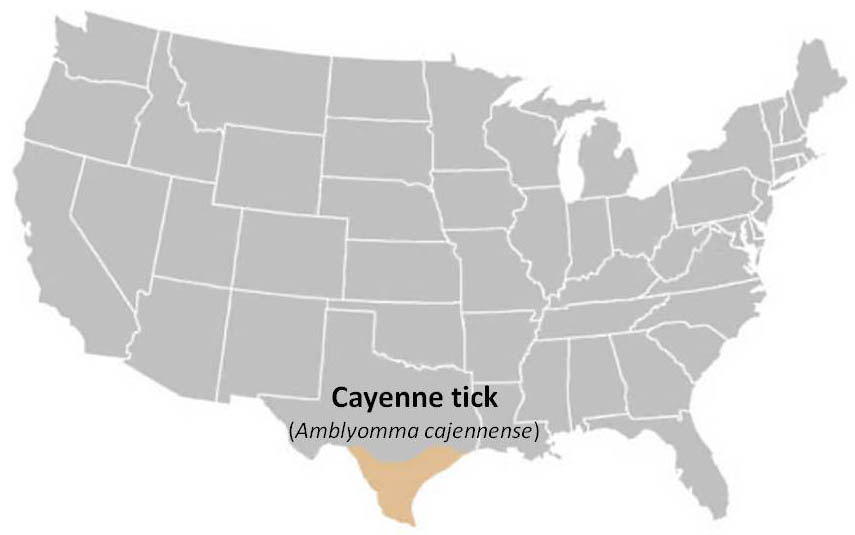
Species: Amblyomma cajennense (Fabricius)
Family: Ixodidae (Acari)
Description: Adult Cayenne ticks have among the longest mouthparts of all native Amblyomma species. Unfed ticks are similar in aggressiveness and overall appearance to lone star ticks, but females lack the white dorsal spot and are uniformly dark brown in color. and present a tan colored scutum overlayed by a dark brown ornation pattern resembling a “pendant necklace”. Females are generally larger than males, and Cayenne tick females average 2-6 mm unfed; 10-15 mm or larger once fully fed. Male ticks average 2-5 mm regardless of feeding duration. Scutum coloration of males ranges tan to golden-beige, often with rust-colored patches amid dark-brown mottled striations.

Distribution: Cayenne ticks are a cold-sensitive species active year-round in tropical and sub-tropical areas of the Caribbean and Mexico, extending southward throughout much of Central and South America. Populations within the U.S. are confined primarily to south Texas, although collections of Cayenne ticks from Florida and coastal regions of other states bordering the Gulf of Mexico have been reported.
Hosts: Cayenne ticks exhibit generalist host preference at all three stages and readily attach to a wide variety of hosts including humans. Larvae and nymphs feed on quail, turkey, rodents, racoons, coyotes, and humans; adult ticks utilize javelina (peccary), deer, cattle, feral swine, horses, sheep, goats, dogs, and humans.
Associated Disease Pathogens: The Cayennne tick is known to carry and transmit Rocky Mountain Spotted Fever (RMSF), Rickettsia rickettsii south of the US border, and is suspected to vector other pathogens throughout much of it’s range. Laboratory studies show A. cajennense capable of transmitting an agent of equine piroplasmosis, Theileria equi.
Similar Tick Species: Cayenne ticks are virtually indistiguishable from Amblyomma imitator in the field. However, the sympatric range of these two species in the U.S. is limited to shrub and brushland areas within the Tamaulipan biome of extreme south Texas.
